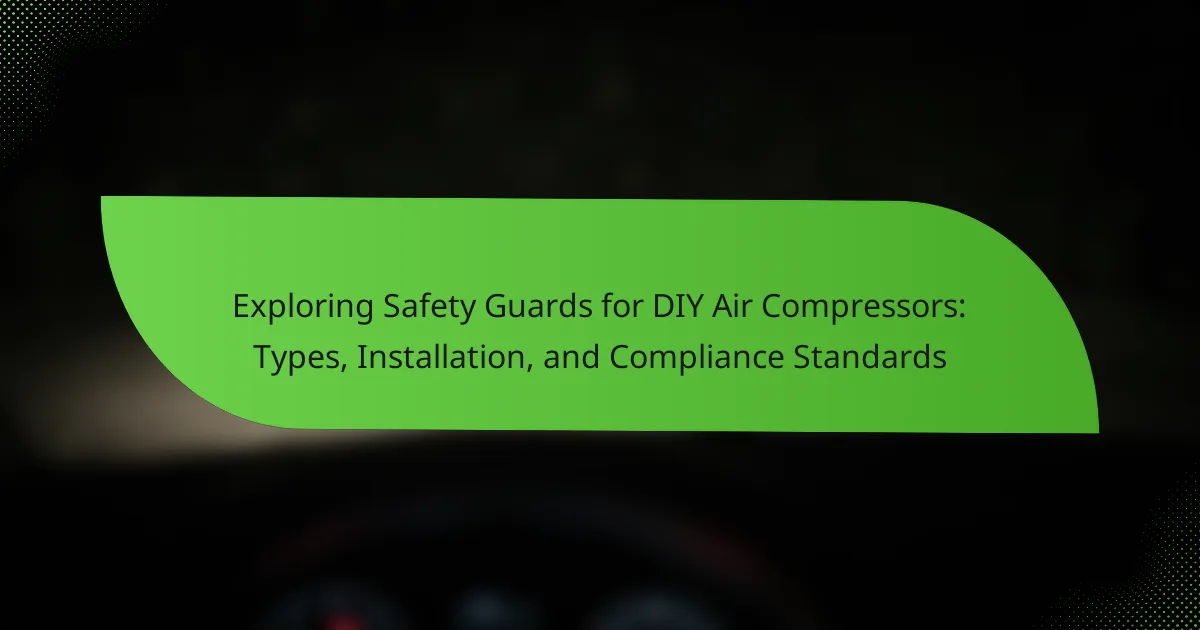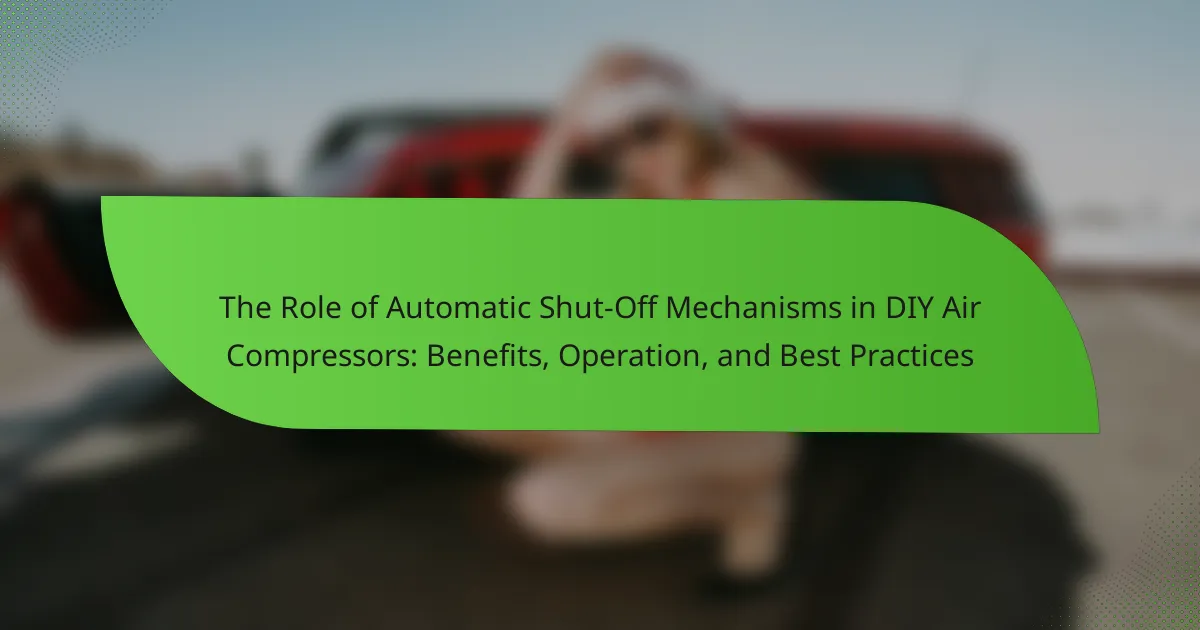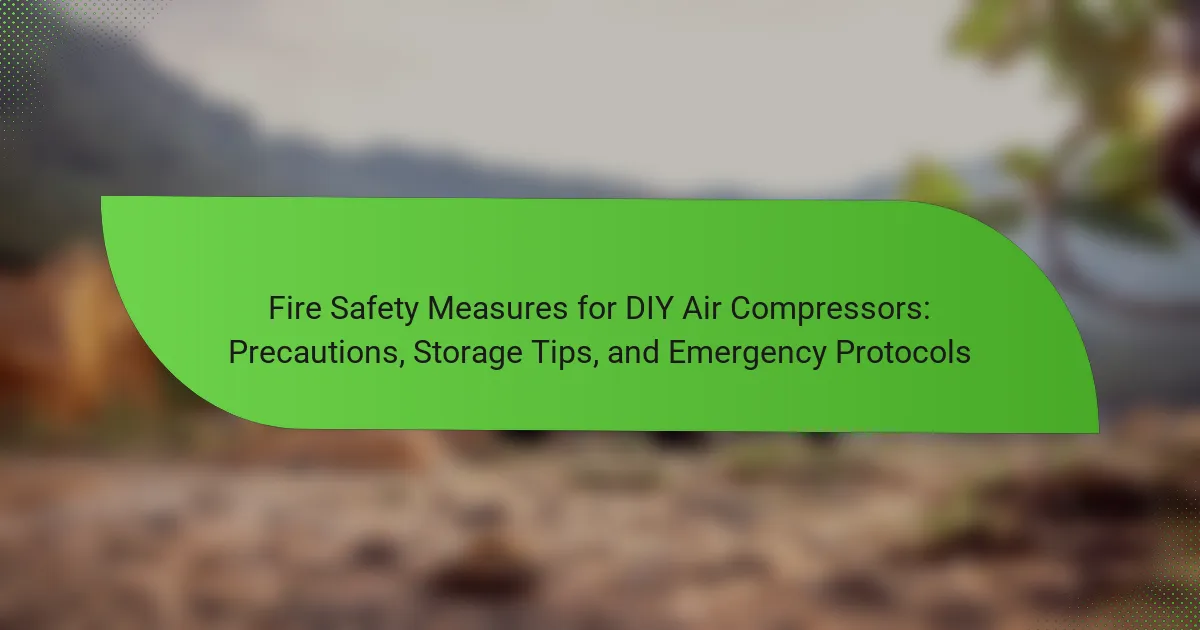DIY air compressors are equipped with crucial safety features that enhance their operational safety and mitigate risks associated with high-pressure air systems. Key components include pressure relief valves, automatic shut-off switches, and thermal overload protection, which work together to prevent over-pressurization, overheating, and potential hazards. Regular maintenance practices, such as inspecting hoses, replacing air filters, and ensuring proper lubrication, are essential for maintaining these safety features. This article provides a comprehensive overview of the essential components, maintenance tips, and user guidelines necessary for the safe usage of DIY air compressors.
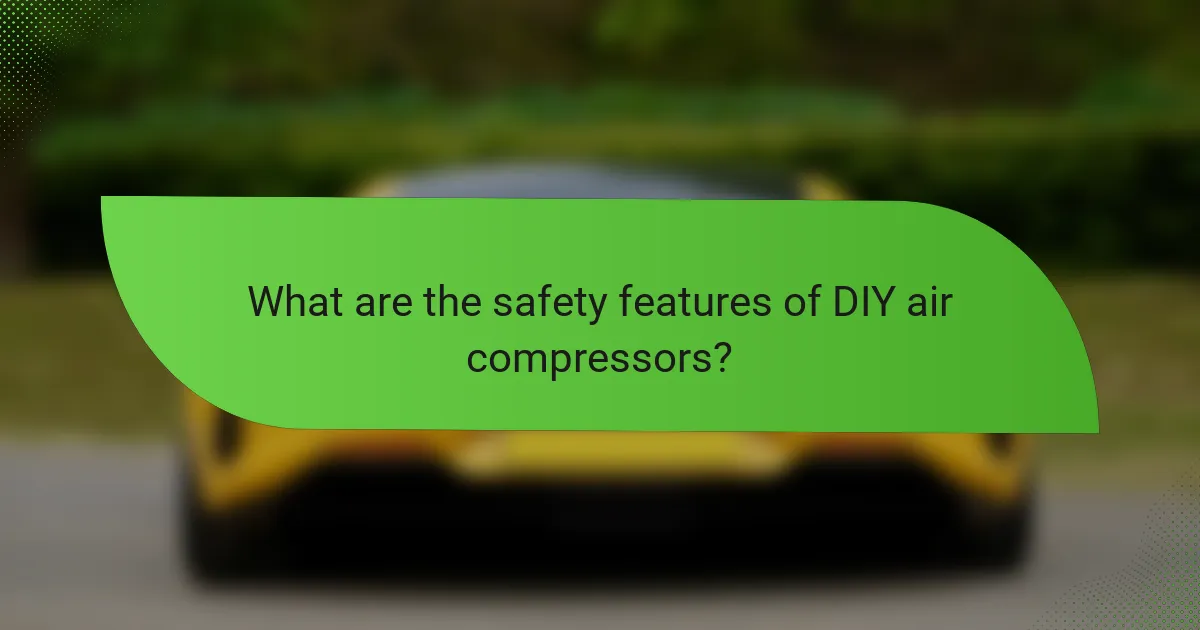
What are the safety features of DIY air compressors?
DIY air compressors typically include safety features such as pressure relief valves, automatic shut-off switches, and thermal overload protection. Pressure relief valves prevent excessive pressure buildup by releasing air when it exceeds a set limit. Automatic shut-off switches turn off the compressor when it reaches a predetermined pressure, ensuring safe operation. Thermal overload protection prevents the motor from overheating, which can cause fires or damage. These features are essential for safe usage and help to mitigate risks associated with high-pressure air systems.
How do safety features enhance the operation of DIY air compressors?
Safety features enhance the operation of DIY air compressors by preventing accidents and ensuring efficient performance. These features include pressure relief valves, which release excess pressure to avoid tank rupture. Automatic shut-off switches prevent the motor from overheating, promoting longevity. Additionally, thermal overload protection safeguards against electrical failures. Properly designed safety guards protect users from moving parts. These enhancements contribute to a safer working environment and reduce the risk of injuries. Overall, safety features are critical for reliable and effective operation in DIY air compressor usage.
What are the key components that contribute to safety in air compressors?
Key components that contribute to safety in air compressors include pressure relief valves, safety switches, and thermal overload protection. Pressure relief valves prevent excessive pressure buildup. They release air when pressure exceeds a safe limit. Safety switches automatically shut off the compressor in case of malfunction. Thermal overload protection prevents overheating by cutting power when temperatures rise too high. These components work together to minimize risks of explosion and equipment failure. Regular maintenance of these safety features ensures reliable operation and user safety.
How do these components prevent accidents and injuries?
Safety features in DIY air compressors prevent accidents and injuries by incorporating mechanisms that reduce risks. These components include pressure relief valves, which prevent over-pressurization. When pressure exceeds safe levels, the valve opens, releasing excess air. This action minimizes the risk of tank explosions.
Additionally, safety guards shield users from moving parts. These guards prevent accidental contact during operation. Automatic shut-off switches further enhance safety by stopping the compressor when it reaches preset limits.
Moreover, thermal overload protection prevents motor overheating. This feature reduces fire hazards associated with excessive heat. Lastly, proper maintenance ensures all components function correctly, which is crucial for safe operation. Regular checks can identify wear or damage early, preventing potential failures.
Why is understanding safety features important for DIY air compressor users?
Understanding safety features is crucial for DIY air compressor users to prevent accidents and injuries. Air compressors operate under high pressure, which can lead to dangerous situations if not managed properly. Familiarity with safety features, such as pressure relief valves and automatic shut-off mechanisms, ensures users can operate the equipment safely. For instance, pressure relief valves prevent tank over-pressurization, reducing the risk of explosions. Additionally, knowing how to use safety goggles and ear protection minimizes the risk of injury from flying debris and noise. Statistics show that improper use of air compressors contributes to numerous workplace injuries annually, highlighting the importance of safety knowledge. Therefore, understanding safety features is essential for effective and safe air compressor operation.
What are the potential risks associated with improper use of air compressors?
Improper use of air compressors can lead to various risks. These include physical injuries, such as cuts or bruises from flying debris. High-pressure air can cause serious damage if directed at the skin. Additionally, misuse can result in equipment failure, leading to potential explosions. Operating an air compressor without proper training increases the risk of accidents. Overloading the compressor can cause overheating, which may lead to fires. Furthermore, inadequate maintenance can result in mechanical failures, creating hazardous situations. Each of these risks underscores the importance of following safety guidelines when using air compressors.
How can knowledge of safety features mitigate these risks?
Knowledge of safety features can significantly mitigate risks associated with DIY air compressors. Understanding these features enables users to operate the equipment safely. For example, pressure relief valves prevent over-pressurization, reducing the risk of explosions. Additionally, safety guards protect users from moving parts, minimizing injury chances. Knowing how to use automatic shut-off systems can prevent overheating and electrical hazards. Familiarity with these features fosters responsible usage and enhances overall safety. Studies show that proper training on safety features reduces accident rates by up to 30%. Therefore, knowledge of safety features is crucial for effective risk management in DIY air compressor use.
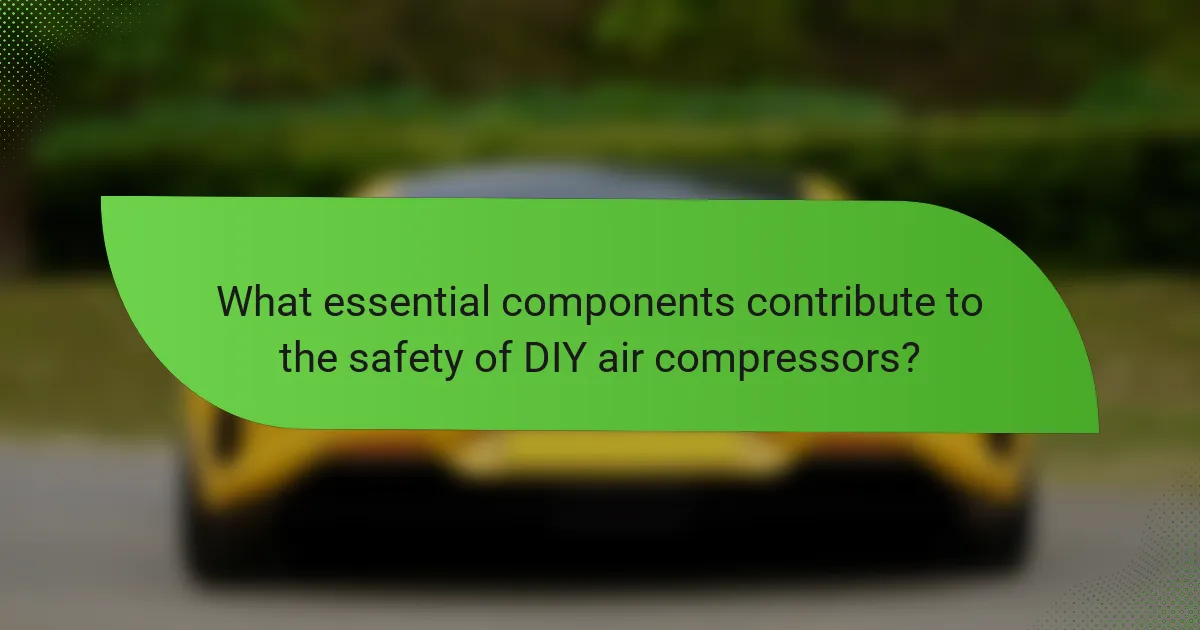
What essential components contribute to the safety of DIY air compressors?
Essential components that contribute to the safety of DIY air compressors include pressure relief valves, safety guards, and proper electrical wiring. Pressure relief valves prevent over-pressurization by releasing excess air, ensuring the compressor operates within safe limits. Safety guards protect users from moving parts and potential hazards during operation. Proper electrical wiring minimizes the risk of short circuits and electrical fires, ensuring safe power supply. Additionally, well-maintained hoses and fittings prevent leaks that could lead to accidents. These components collectively enhance the operational safety of DIY air compressors, reducing the likelihood of injuries and equipment failure.
What types of safety valves are commonly used in air compressors?
The types of safety valves commonly used in air compressors include pressure relief valves, safety pop-off valves, and adjustable safety valves. Pressure relief valves automatically open to release excess pressure, preventing damage to the compressor. Safety pop-off valves are designed to vent air when pressure exceeds a preset limit. Adjustable safety valves allow users to set the pressure threshold according to their needs. These valves ensure safe operation by preventing over-pressurization. Proper selection and maintenance of these valves are critical for safety and efficiency in air compressors.
How do safety valves function to protect users?
Safety valves function by automatically releasing excess pressure to prevent dangerous over-pressurization. They are designed to open when the internal pressure exceeds a predetermined limit. This action helps to maintain safe operating conditions within the system. When the pressure is released, it protects users from potential injuries or equipment damage. Safety valves are critical in systems like air compressors, where high pressure can lead to catastrophic failures. By ensuring that pressure remains within safe limits, these valves enhance user safety significantly.
What maintenance practices ensure the reliability of safety valves?
Regular inspection and testing of safety valves ensure their reliability. Safety valves should be checked for leaks, corrosion, and proper seating. Routine testing involves simulating operating conditions to confirm function. Cleaning of the valve and surrounding area prevents debris buildup. Calibration should occur periodically to maintain accurate pressure settings. Documentation of maintenance activities supports compliance and helps track performance. Following manufacturer guidelines enhances valve longevity and reliability. Adhering to these practices minimizes the risk of valve failure in critical applications.
How does the pressure regulator enhance safety in DIY air compressors?
The pressure regulator enhances safety in DIY air compressors by controlling the air pressure output. It prevents excessive pressure buildup, which can lead to equipment failure or accidents. By maintaining a consistent pressure, the regulator ensures safe operation of tools and attachments. This reduces the risk of hose bursts or blowouts, which can cause injuries. Additionally, pressure regulators often have safety features like pressure relief valves. These valves automatically release excess pressure, providing an extra layer of protection. Overall, the pressure regulator is essential for safe and effective use of air compressors.
What are the signs of a malfunctioning pressure regulator?
Signs of a malfunctioning pressure regulator include inconsistent pressure readings. Users may notice fluctuating air pressure during operation. There can be audible hissing or leaking sounds. Additionally, the regulator may fail to maintain set pressure levels. This can lead to over-pressurization or under-pressurization of the system. Visible damage to the regulator body may also be present. If the regulator is excessively hot to the touch, it indicates potential issues. Regular inspection can help identify these signs early.
How can users properly adjust and maintain the pressure regulator?
To properly adjust and maintain the pressure regulator, users should first ensure the compressor is turned off and disconnected from power. Next, they should locate the adjustment screw on the pressure regulator. Turning this screw clockwise increases the pressure, while counterclockwise decreases it. Users must then check the pressure gauge to confirm the desired pressure is achieved. Regularly inspecting for leaks and ensuring all connections are tight is essential for maintenance. Additionally, users should clean the regulator periodically to prevent debris buildup. Following these steps helps ensure optimal performance and safety of the air compressor system.
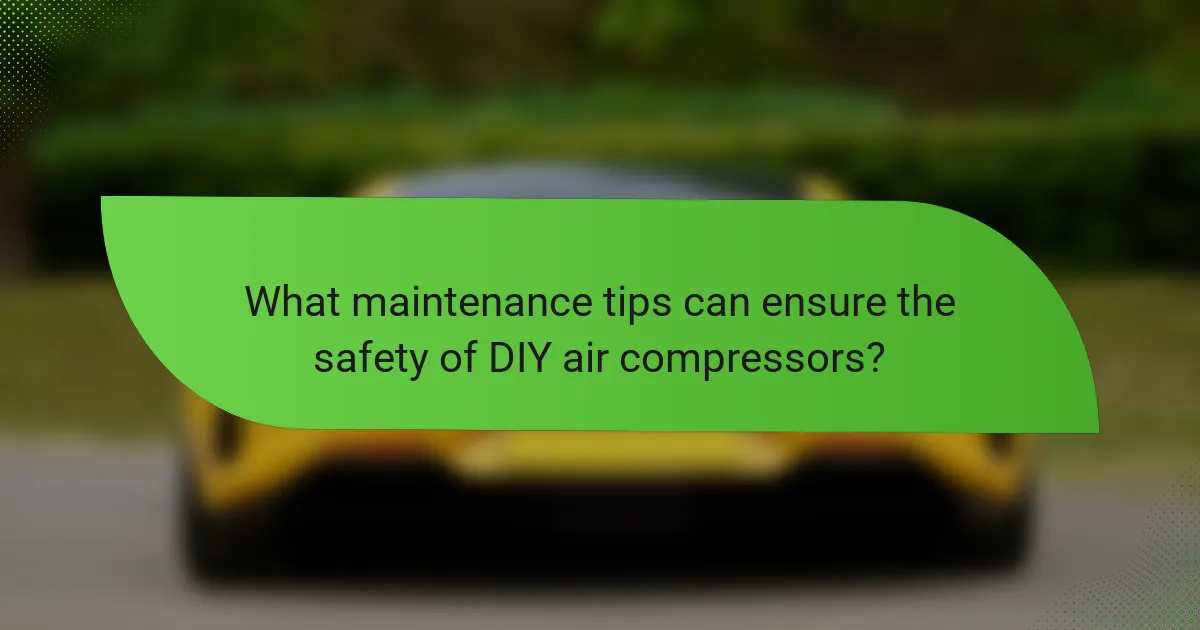
What maintenance tips can ensure the safety of DIY air compressors?
Regular maintenance of DIY air compressors is essential for ensuring their safety. Check the air filter frequently and replace it if it appears dirty. Inspect the hoses and connections for any signs of wear or leaks. Tighten any loose fittings to prevent air loss. Drain the moisture from the tank regularly to avoid corrosion. Test the safety valve by pulling the ring to ensure it functions properly. Keep the compressor lubricated according to the manufacturer’s guidelines. Store the compressor in a dry, cool place to prevent damage. Following these tips helps maintain optimal performance and safety.
How often should users inspect their DIY air compressors for safety?
Users should inspect their DIY air compressors for safety at least once a month. Regular inspections help identify wear and tear or potential hazards. Checking the air compressor monthly ensures all safety features function correctly. Additionally, users should inspect after heavy usage or if the compressor has been stored for a long period. Inspections should include checking for leaks, ensuring proper lubrication, and verifying safety valves are operational. Following these guidelines enhances user safety and prolongs the lifespan of the air compressor.
What specific components should be checked during inspections?
During inspections of DIY air compressors, specific components must be checked for safety and functionality. These components include the pressure relief valve, which prevents over-pressurization. The air filter should be inspected to ensure it is clean and unobstructed. Additionally, the hoses must be checked for leaks or damage. The regulator should function properly to control air pressure. The oil level in oil-lubricated compressors needs to be monitored for adequate lubrication. Electrical connections should be secure and free from corrosion. Lastly, the overall physical condition of the compressor should be assessed for any signs of wear or damage. Regular checks of these components help maintain safety and performance standards.
How can regular maintenance prevent safety hazards?
Regular maintenance prevents safety hazards by ensuring that equipment functions correctly and safely. It identifies potential issues before they escalate into dangerous situations. For example, checking air compressor hoses for wear can prevent leaks that might lead to pressure bursts. Regularly inspecting safety valves ensures they operate properly, reducing the risk of over-pressurization. Cleaning filters prevents blockages that can cause overheating. According to the Occupational Safety and Health Administration (OSHA), proper maintenance reduces workplace accidents significantly. Regular maintenance can lower the risk of equipment failure by up to 30%, promoting a safer work environment.
What user guidelines should be followed for safe operation of DIY air compressors?
Always wear appropriate personal protective equipment when operating DIY air compressors. This includes safety goggles, gloves, and hearing protection. Ensure the compressor is placed on a stable surface to prevent tipping. Regularly check for leaks in hoses and connections to avoid accidents. Maintain a safe distance from flammable materials while using the compressor. Follow the manufacturer’s guidelines for pressure settings to prevent overloading. Keep the area well-ventilated to avoid inhaling harmful fumes. Lastly, turn off the compressor and release pressure before performing any maintenance. These guidelines help ensure safe operation and reduce the risk of injury or damage.
What personal protective equipment is recommended for users?
Recommended personal protective equipment for users includes safety goggles, hearing protection, and gloves. Safety goggles protect the eyes from debris and harmful substances. Hearing protection, such as earplugs or earmuffs, reduces noise exposure from the compressor. Gloves provide hand protection against sharp objects and chemical exposure. Additionally, a dust mask may be recommended to prevent inhalation of harmful particles. Wearing appropriate footwear is also advised to protect feet from heavy equipment. These recommendations align with safety guidelines established by organizations like OSHA.
How should users handle and store air compressors safely?
Users should handle and store air compressors in a safe manner to prevent accidents. Always turn off and unplug the compressor before moving it. Ensure that the compressor is drained of air and moisture before storage. Store the compressor in a cool, dry place to prevent rust and damage. Keep the compressor away from flammable materials and heat sources. Use proper lifting techniques when moving heavy compressors to avoid injury. Regularly inspect the compressor for leaks and damage to ensure safe operation. Following these guidelines helps maintain safety and prolongs the life of the air compressor.
What are common troubleshooting tips for safety issues in DIY air compressors?
Check for leaks in hoses and fittings. Leaks can cause pressure loss and pose safety risks. Inspect the pressure relief valve regularly. A malfunctioning valve can lead to over-pressurization. Ensure the air compressor is grounded properly. Improper grounding can create electrical hazards. Monitor the temperature of the compressor during use. Overheating can indicate mechanical failure. Use appropriate personal protective equipment. This minimizes injury risks during operation. Regularly maintain the compressor according to the manufacturer’s guidelines. Proper maintenance reduces the likelihood of safety issues.
The main entity of this article is DIY air compressors, focusing on their safety features. Key safety components such as pressure relief valves, automatic shut-off switches, and thermal overload protection are essential for preventing accidents and ensuring safe operation. The article also outlines maintenance tips, user guidelines, and common troubleshooting practices to enhance safety and reliability. Understanding these safety features is crucial for users to mitigate risks associated with high-pressure air systems and promote effective operation.
